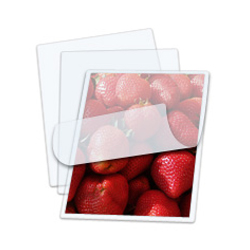“Why Won’t My Laminating Film Stick?”
Adhesives interact with paper and ink toner coverage differently. When selecting laminating film, it is important to note the film’s content ratio: when the ratio of film and adhesive are combined, they equal the film’s total thickness. Film that is made with stronger adhesive provides better adhesion, and often uses a lower melting temperature than more basic adhesives. A higher ratio of film to adhesive provides a thicker finished result and increased clarity compared to films that have a high adhesive content.
Below are some common scenarios with the recommended type of film to use for each:
“I am laminating standard copier paper with light ink coverage.” Standard 20 lb. copier paper is a porous material that can be laminated with standard laminating film, including the school-grade laminating rolls commonly used by schools. Light ink coverage, such as the amount used on text-based documents with simple illustrations, provides the best base for laminating with standard-grade film.
“We are a school that laminates construction paper projects.” Construction paper generally has higher acidity than regular copy paper, which causes it to resist standard laminating adhesive and makes it difficult to adhere to. To ensure adhesion, select a film with a stronger adhesive like professional-grade laminating film; it can also be used on documents with high ink coverage, as well as paper with a glossy finish like the stock used for posters or teaching aids. PRO film is also an excellent choice for professional printers and print shops. The additional benefit of using PRO versus standard is that PRO film activates at a lower temperature – saving energy and resulting in less heat damage to your print.
“I am laminating teslin [or permanent paper].” We highly recommend using DIGIKote laminating film for this type of project since it has an aggressive adhesive content and activates at the lowest temperature of all the thermal laminating films available. This results in better fusion between the teslin layer and the adhesive.
“I am laminating paper stock covered in oil-based ink toner.” Either DIGIKote or Nylon Xtreme Bond laminating film is the best option in this case. Nylon has the ability to lay flat, which allows film to be applied to only one side of a project using a single-sided laminator. Nylon Xtreme Bond has one of the strongest adhesives available and is validated by Xerox.
“I am laminating a vinyl car wrap.” Vinyl is a non-porous material, which does not marry well with thermal laminating films because the adhesive simply slides along its surface and has nothing onto which it can attach. Pressure-sensitive laminating film (also called “cold laminating film“) is ideal for non-porous materials like the vinyl that is used for magnets or car wraps since the film’s adhesive is self-sticking and requires no heat to activate. Furthermore, the cold laminating process won’t degrade heat-sensitive, solvent-based inks like thermal laminating can.
We’re happy to answer any specific questions you may have! Please ask us in the comment section, and we’ll give you a solution for your project.
